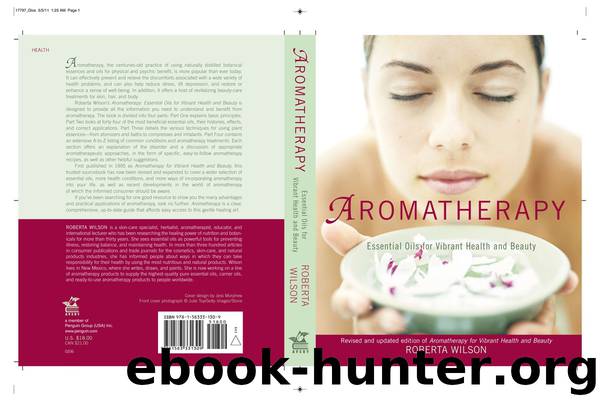Aromatherapy by Roberta Wilson

Author:Roberta Wilson
Language: eng
Format: epub
Published: 2018-12-03T16:00:00+00:00
Essential Oils
Essential oils are essences that are extracted from the bark, leaves, petals, resins, rinds, roots, seeds, stalks, and stems of certain aromatic plants. Essential oils are what give plants their characteristic smells. Pure essential oils are extremely concentrated. Many pounds, even tons, of plant material may be required to produce a relatively small amount of essential oil. For example, more than 150 pounds of lavender flowers will yield only 1 pound of lavender oil; approximately 5,000 pounds of rose petals produce but 1 pound of rose oil.
Essential oils are not oils in the same sense as vegetable oils like almond, olive, or sunflower oils. Essential oils are usually very liquid and do not feel greasy at all. Most will not leave an oily stain on clothing or paper. Essential oils are sometimes called volatile oils because they evaporate readily when exposed to air. They are soluble in vegetable oil and partially soluble in alcohol. However, they do not readily dissolve in water.
Sometimes essential oils are referred to as plant essences. The word essence can mean “heart,” “soul,” or “spirit.” Indeed, essential oils are the heart, soul, and spirit of aromatic plants. They contain the vital energy and the life force of the plants. Aromatic plants store essential oils in tiny pockets between their cell walls. As the plant releases the essential oils, they circulate throughout the plant and send messages that help it function efficiently, much as hormones do in humans. Many botanists believe that essential oils activate and regulate such activities as cellular metabolism, photosynthesis, and cellular respiration. Some scientists speculate that essential oils may trigger immune responses that assist plants in coping with stressful changes in climate and environment. Some plants release essential oils that protect them by repelling harmful insects and diseases, while others emit essential oils to attract insects or animals that aid in the plants’ pollination and propagation. Essential oils thus play an important part in the daily life and survival of plants.
Of the thousands of plants that populate the plant kingdom, relatively few produce essential oils. Even among those that do produce essential oils, many yield such a minute amount that it is not financially feasible to extract them. Other plants produce essential oils, yet the oils smell nothing like the plants; often, this is due to chemical reactions that occur during the extraction process.
Ironically, some of nature’s most fragrant flowers—gardenia, lilac, lily of the valley, magnolia, violet, and wisteria—yield no essential oils through steam distillation. Some flowers, such as carnation, honeysuckle, and narcissus, yield absolutes through solvent extraction (see page 23), but they are quite costly and smell little like the original flowers. Most fruits, with the exception of some citrus fruits, do not produce essential oils. Scents such as apple, banana, cherry, coconut, mango, papaya, peach, pear, pineapple, raspberry, strawberry, and watermelon are not essential oils. Scientists in chemistry labs synthesize these fragrances from petrochemicals or fossil fuels. They are inappropriate for inhalation or therapeutic purposes. Frequently, synthetic scents can aggravate the problems or symptoms that the pure essential oils could ease or relieve.
Download
This site does not store any files on its server. We only index and link to content provided by other sites. Please contact the content providers to delete copyright contents if any and email us, we'll remove relevant links or contents immediately.
| Acupuncture & Acupressure | Aromatherapy |
| Ayurveda | Chelation |
| Chinese Medicine | Energy Healing |
| Healing | Herbal Remedies |
| Holistic | Homeopathy |
| Hypnotherapy | Massage |
| Meditation | Naturopathy |
| Reference |
Inner Engineering: A Yogi's Guide to Joy by Sadhguru(6758)
The Power of Now: A Guide to Spiritual Enlightenment by Eckhart Tolle(5683)
Fear by Osho(4702)
Ikigai by Héctor García & Francesc Miralles(4177)
The Art of Happiness by The Dalai Lama(4098)
The Ultimate Bodybuilding Cookbook by Kendall Lou Schmidt(3909)
Yoga Therapy by Mark Stephens(3723)
The Little Book of Hygge by Meik Wiking(3665)
The Healing Self by Deepak Chopra(3532)
Why Buddhism is True by Robert Wright(3426)
The Hatha Yoga Pradipika (Translated) by Svatmarama(3285)
Being Aware of Being Aware by Rupert Spira(3248)
Shift into Freedom by Loch Kelly(3168)
Wild Words from Wild Women by Stephens Autumn(3118)
Work Clean by Dan Charnas(3081)
Happiness by Matthieu Ricard(3024)
More Language of Letting Go: 366 New Daily Meditations by Melody Beattie(3004)
Yoga Body & Mind Handbook by Jasmine Tarkeshi(2850)
Why I Am Not a Feminist by Jessa Crispin(2727)
